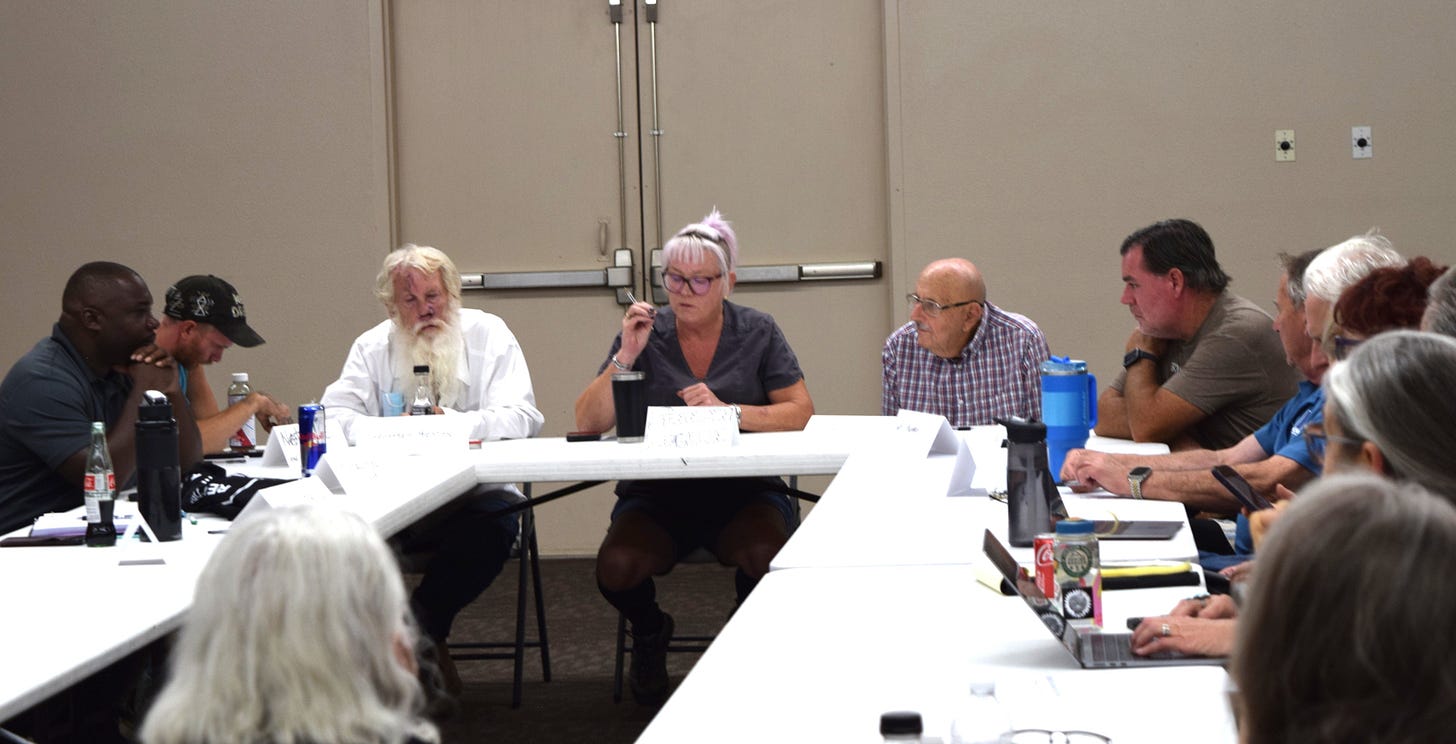Community Roundtable on Housing & Homelessness, October 8, 2025
“Start with safety, sleep, and respect”
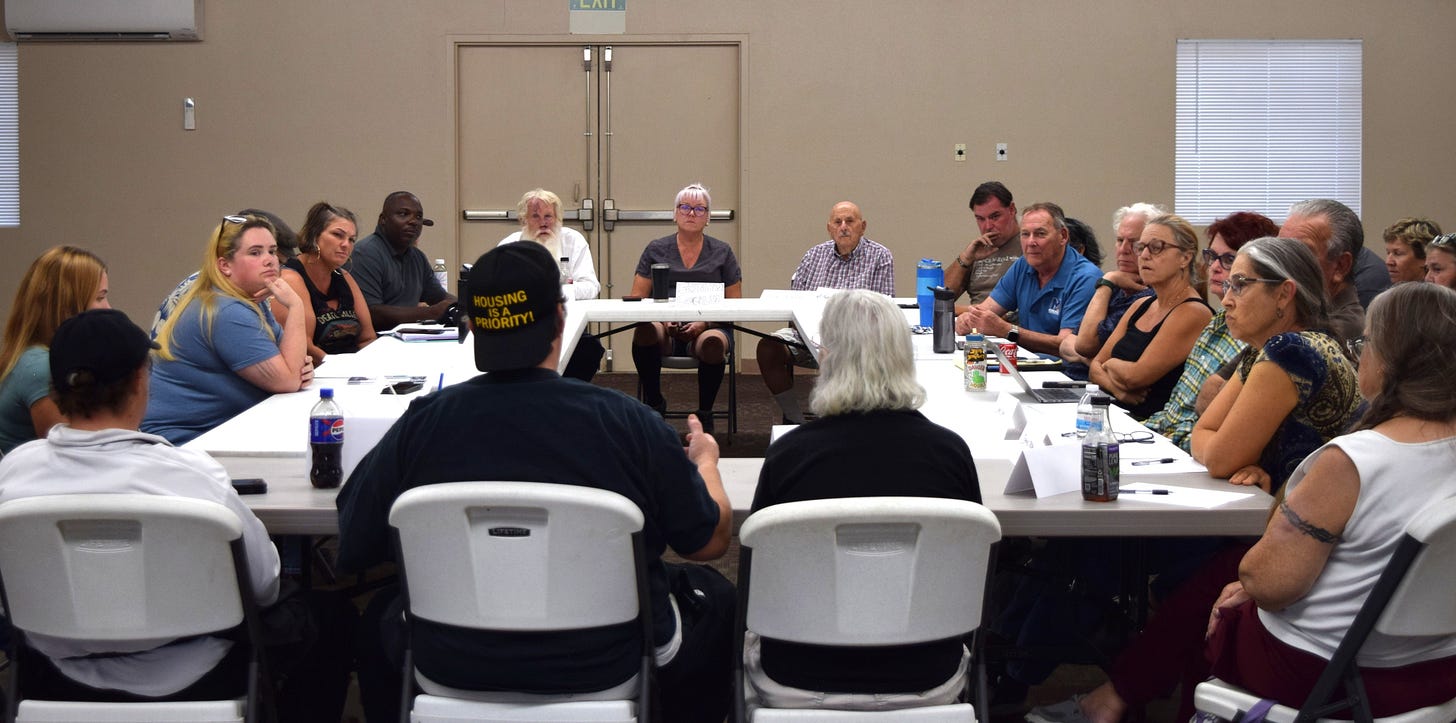
At a community discussion convened by Twentynine Palms City Councilmember Octavious Scott, over forty attendees made up of service providers, volunteers, and residents traded first-hand accounts of homelessness in the Morongo Basin and pushed for near-term action alongside longer-term fixes.
The Desert Trumpet has reported extensively on housing and homeless issues in its recaps of City Council and Planning Commission meetings; it has also held town halls and candidate forums where the issues have been discussed.
Here is a sampler:
Self-Build Housing Initiative Comes to a Boil, May 5, 2025
Twentynine Palms Selects Religious Nonprofit for “Resilience Center” Partner, November 17, 2024
Questions to City Council Candidates, October 3, 2024
Creating an Affordable and Sustainable City: 29 Palms Town Hall, July 7, 2024
Why This Meeting? Why Now?
Councilmember Octavious Scott, who sits on the City’s Housing and Homeless Subcommittee, opened the session with simple ground rules: “speak effectively, focus on solutions, keep comments brief.” He challenged attendees to identify barriers, share insights, and shape recommendations for City action.
An abundance of diversity and expertise filled the room, including those with lived experiences of being unhoused. From disabled veterans to board members, street-medicine teams, a San Bernardino County liaison, faith and mutual-aid volunteers, behavioral health staff, and concerned citizens, both longtime and new, all gathered with the common cause of addressing housing and homelessness in Twentynine Palms.
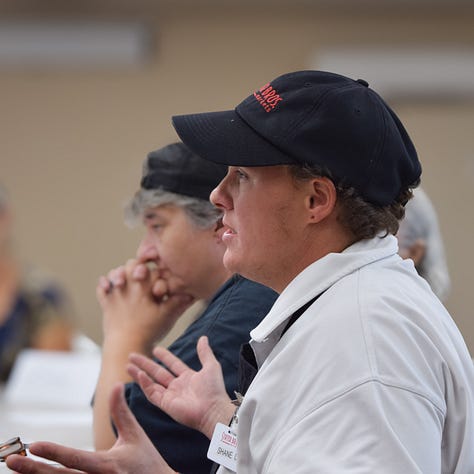
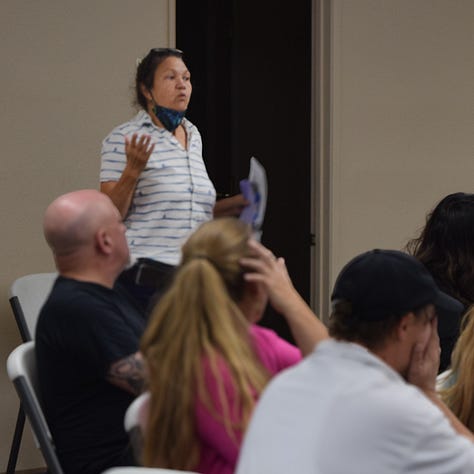
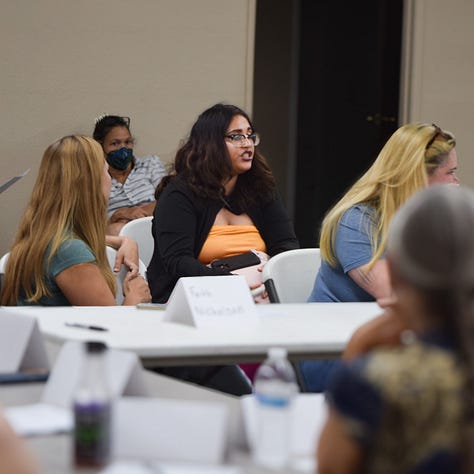
Among the attendees were:
Wellness Equity Alliance, represented by Jennifer Art, who described herself as a member of a street-medicine team
Beth Williams, board member of Reach Out Morongo Basin
Faith Nicholson with Valley Star Community Services (TAY/Young Adult programs)
Janet Johnston, Director of the Morongo Basin Conservation Association
Act of Kindness, which provides meal, clothing, and hygiene outreach, and which was represented by Jenn and Shane DeFalco
Gladys Cardenas, community healthcare worker with the Morongo Basin Healthcare District
Local volunteers who feed the unhoused, offer clothing, and field donation drives
Residents with lived experience of homelessness and family members who’ve navigated services
Concerned citizens, seniors, and new arrivals seeking ways to help
Councilmember Scott was the only City official present, and though the meeting wasn’t formally sponsored by the City, a nonprofit, or any formal board or organization, there was an agenda with discussion topics.
Speakers weren’t limited to three minutes of speaking time typical with civic meetings, which meant ideas were exchanged freely, openly, and honestly. Despite the typical formalities, everyone respected one another with action items and community networking in mind.
Discussion: “What factors have contributed to housing instability here in the Morongo Basin?”
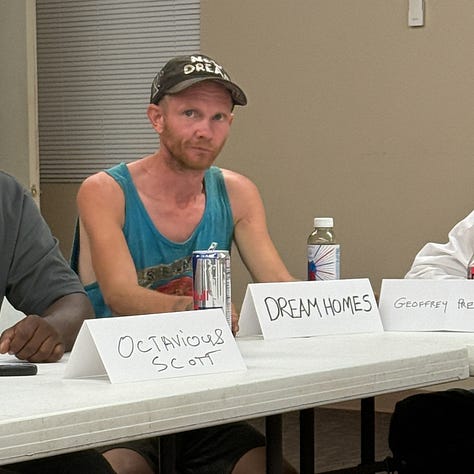
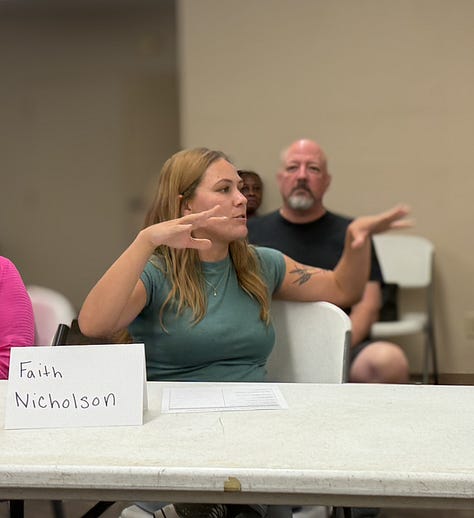
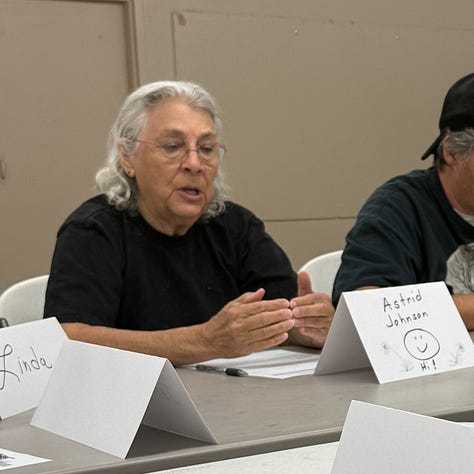
Jenn DeFalco vouched for unhoused youth, citing issues with the local foster care system, and emphasized that housing should be a main priority:
If we don’t get people housed, they can’t shower, they can’t clean their clothes, they can’t sleep—and they can’t be productive the next day.
Lack of jobs was a common talking point. Councilmember Scott suggested a workforce development program that could assist local youth.
Others spoke of services being tied to probation programs, or housing services only available to individuals seeking drug rehabilitation services.
Nathaniel Rudd, who has an idea for a nonprofit organization called Dream Homes with hopes to someday build a local shelter with year-round cooling and heating, shared his interactions with County service providers:
I told them countless times, “I don’t have any drug problems or mental health issues. Is there any help you can do for me?” And they said, “Nope, nothing we can do for you.”
Faith Nicholson, outreach specialist with Valley Star Community Services, who first introduced herself by noting her own personal experience being unhoused, affirmed Rudd’s interactions:
He’s correct. A lot of those homeless services out here, you need to qualify, you need to have a mental illness, you have to have a record, you have to have drug involvement. And a lot of these people, they don’t have those yet. But if we don’t help them, they will eventually turn to them to fall into those qualifications.
Issues with Quality of Homelessness Services Provided
Those with grant and nonprofit experience highlighted that funding sources often require individuals to provide an ID card, social security number, or address in order to receive services— an administrative hoop for the unhoused to jump through. Jennylyn Laughlin raised issues with a recent mobile shower event sponsored by the Morongo Basin Community Coalition in which nine individuals were assisted, according to meeting attendees:
You get them to come out because you say, “Let’s get you a shower,” then all of a sudden we’ve got, “What’s your social security number?” “What’s your problem?” “What’s your disability?” “Are you a veteran?” “What’s wrong with you?” And then we let people lay in the hot sun for two and a half hours and nobody checks on them. That’s not what we should be doing here, folks.
Laughlin continued:
I think that a lot of our organizations that are represented here, or that we work for, are considered wolves in sheep’s clothing. We lure these people out from their encampments in order to get a shower while somebody goes in and cleans out their camp.
We also make a spectacle out of it when we put it up on the highway. So who wants to go shower and receive services where everybody can see what everybody else is doing? Have some humility, have some dignity for these people and treat them like humans.
Jenn DeFalco also raised concerns with the recent mobile shower event, citing poor interactions with the driver of the shower unit:
It was all very nice until I’m told by a couple of the unhoused that the driver of the mobile shower was very rude to them and made them feel very uncomfortable. Now, I don’t know if this driver was a part of the Community Action Partnership or if it was an independent driver, but a problem when you’re dealing with [the unhoused] is you have to learn to be sensitive— you have to learn to talk with the same courtesy that you talk to everybody else with.
Meeting attendees also provided an update on an unhoused individual who they say did not receive proper medical services for a leg infection at the local hospital. Following advocacy efforts from community members, the individual is now receiving crucial services in the Victorville area.
Another mobile shower event is set to take place in town October 20 from 9 am-2 pm at the Star Lite Inn, 71829 29 Palms Hwy, Twentynine Palms, CA 92277.
“If We Build It, They Will Come” Caveat
Councilmember Scott, who at times was unable to comment on issues discussed at the meeting due to his affiliation with the City Council and regional subcommittees, raised that one issue residents have regarding a shelter or resource center is one of “if you build it, they will come.”
There’s a fear out there by some residents that, you know, if we provide shelter for our unhoused residents, then it’s going to make it so that we get more unhoused residents— that people will be shipped here. I don’t know if I completely agree with that. I mean, there’s shelters in Palm Springs and Victorville. I don’t think they’d be shipping people to Twentynine Palms, but that is a challenge.
Community need for a resource center was a common theme. Previously, the City of Twentynine Palms allocated money for a resource center through Morongo Basin ARCH but those plans dissolved. Astrid Johnson, who formerly worked with ARCH, expressed her desire to secure a physical building that provided community resources.
Councilmember Scott said one of the challenges with addressing homelessness in Twentynine Palms is that the majority of assistance programs are located in Yucca Valley. Other services are contingent on numbers reported during the County’s point-in-time count (PITC), which reported a decrease in homelessness in 2025, down from previous years. Attendees like De Falco and Laughlin had concerns with how the PITC was conducted, suggesting regional unhoused numbers have been significantly underreported and failed to include locations like Wonder Valley and Landers.
Impassioned meeting attendees called out local politicians and elected officials. Kristin Brock said:
We all have something to bring to the table….There are many of us who know how to build things. We know how to plant gardens, do emotional triage. We don’t need the local government to do anything, and clearly they don’t want to. Because it shows in their actions— if they wanted to, they would. They have the money, they have the time— they’re not doing it. Believe what they do, not what they say. And I’m over the lip service.
You’re either showing up, making the world better, or you’re not. And there is no reason why we cannot all come together right now in this moment or plan another meeting. And in this next meeting, we all bring what we can contribute. “I have an extra bedroom.” “I have a back house.” “I have an Airbnb.” You go out and you talk to every houseless person up here, and you say, “Hi, what’s your name? My name is Kristen. What are you looking for?” Not, “What is your five year plan?”
Nonprofit “Wolves in Sheep’s Clothing”
Jennylyn Laughlin highlighted issues with local nonprofits and the vast sums of government money being thrown at the issue without audits, saying the current County budget allocates more than $70,000 per unhoused individual:
We have no accountability for a lot of these 501C-1-through-29s that we’ve got. They don’t show us numbers. They make up numbers. They present false numbers, without explaining where those numbers come from.
Erica Watkins, Administrative Manager for the San Bernardino County Community Development and Housing Department, spoke at the meeting, noting that a lot of the County’s administrative shortfalls were due to HIPAA (Health Insurance Portability and Accountability Act of 1996) and privacy concerns that prevented interagency information sharing on individual cases.
The County of San Bernardino implemented a Homeless Management Information System to address this issue.
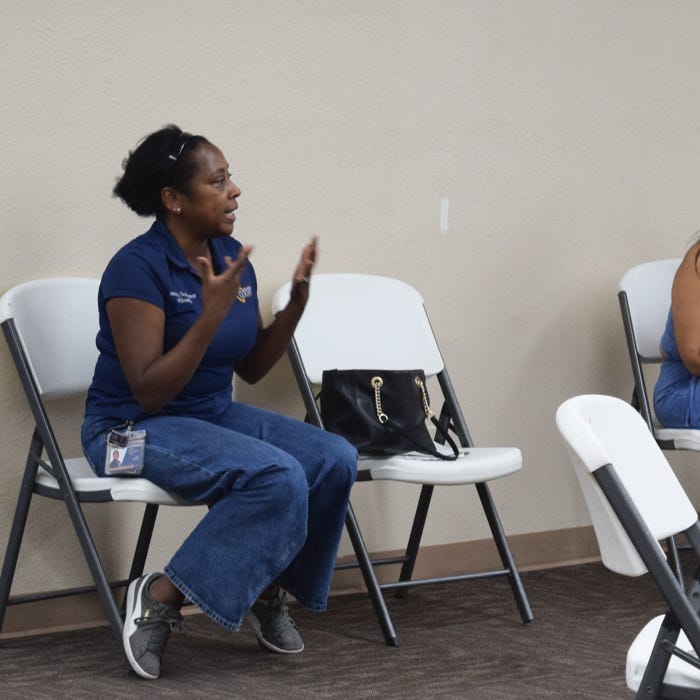
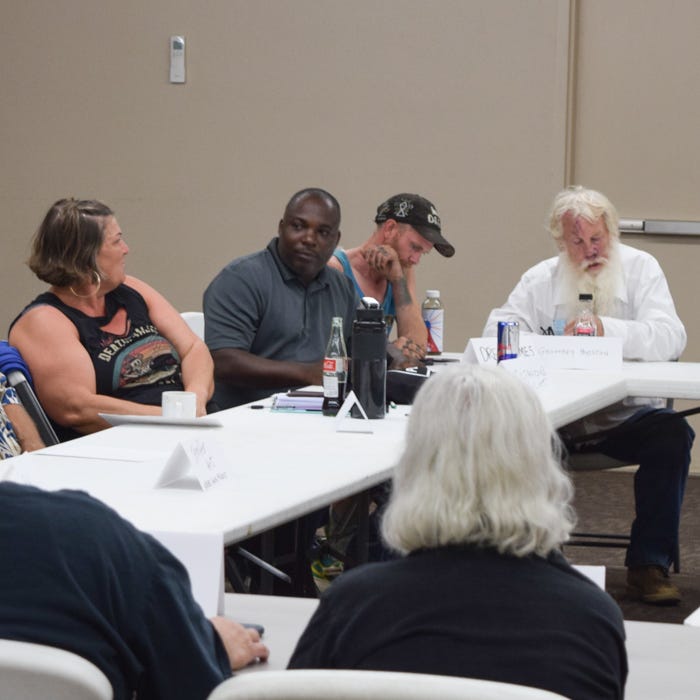
Watkins highlighted the County’s vast geographic size1 as one major obstacle in addressing housing and homelessness. Services are allocated to regions with larger populations, such as the City of San Bernardino, while rural areas with lower populations, like the Morongo Basin, go without.
Closing Thoughts
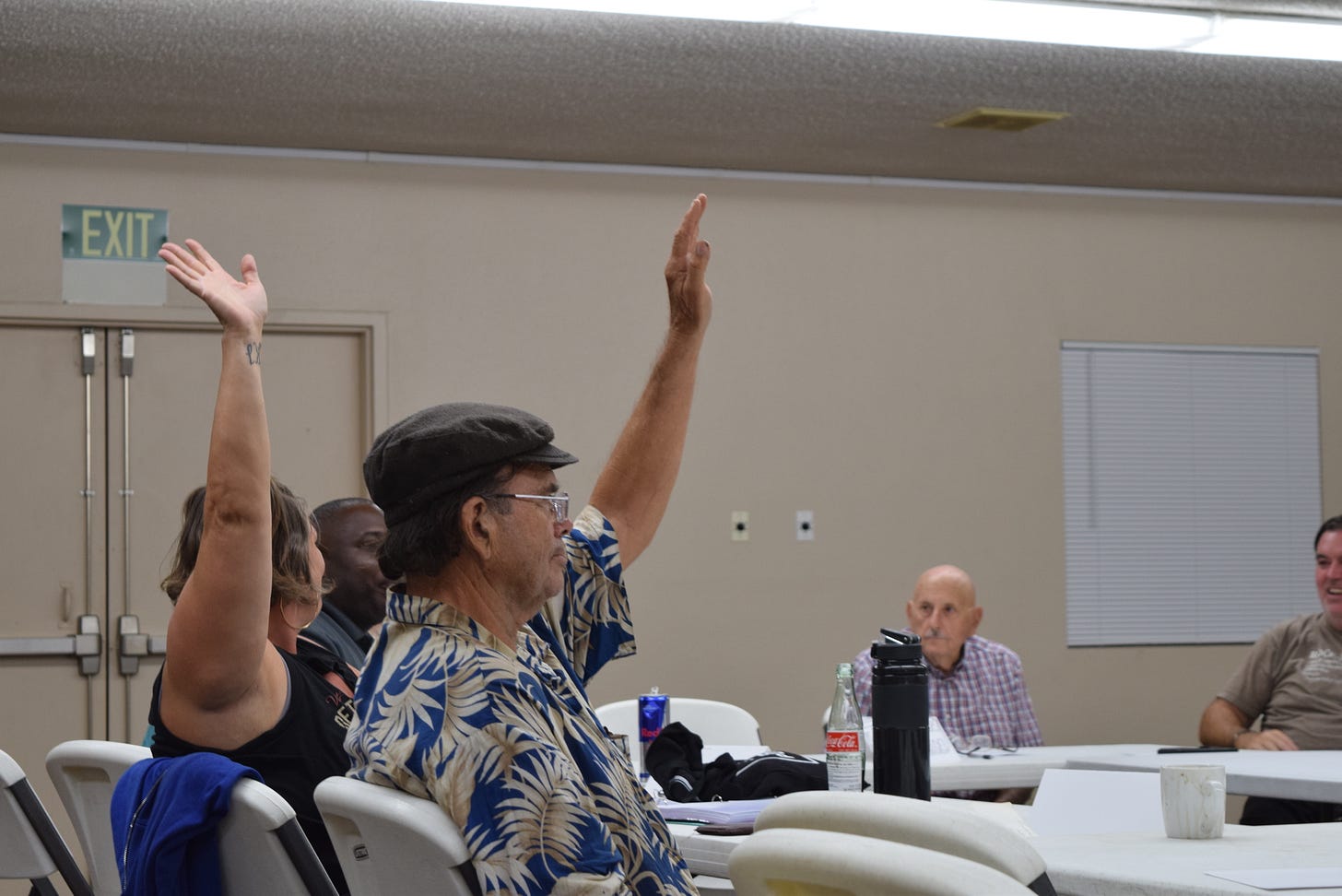
The evening closed not with easy answers but with a shared resolve. What began as a listening session evolved into a collective call for action, one rooted in compassion, accountability, and the belief that every person deserves stability and dignity. As emails and ideas were exchanged, participants signaled that this was just the start of an ongoing effort. Jenn DeFalco highlighted the urgency of these community volunteer efforts, saying nights have turned cold, and blankets are needed now.
When asked by Councilmember Scott if attendees would like another meeting, hands raised with enthusiasm. Whether through volunteer networks, policy change, or simply showing up, those gathered made clear that addressing homelessness in Twentynine Palms will take more than talk. It will take a community willing to keep coming back to the table.
Contact Councilmember Octavious Scott (oscott@29palms.org) to be added to a mailing list he has initiated.
Leave your thoughts in the comments below. Please note that we do not allow anonymous comments. Please be sure your first and last name is on your profile prior to commenting. Anonymous comments will be deleted.
Feel free to share this article!
We are $105 away from $7000 in paid subscriptions! Who’s going to take us over $7,000? Upgrade to a paid subscription for just $5 per month or $50 per year.
Would you care to donate more than $100? Our Paypal account is up and running!
San Bernardino County covers over 19,000 square miles, making up the largest county in the contiguous United States with only territories in Alaska being comparable in size.



